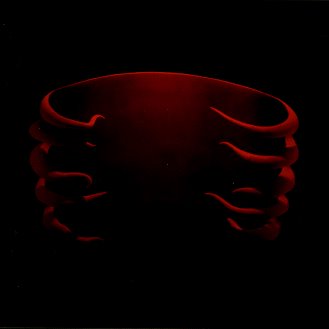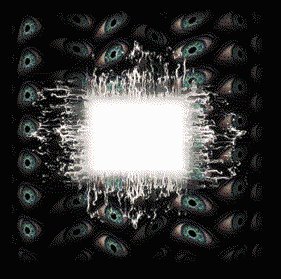Today I shall bring a touch of classic culture to this blog.
Previous meanderings and discertations on songs of more recent genres require adequate balance with more analysis on the whole skeleton of music:
TO me that means : Instrumentation.
The case study today will be the absolutely ingenious, and beautiful OST of the japanese movie
"Be with you" @ " Ima ai ni yukimasu" ( if i'm not wrong)
This OST is just amazing for more reasons than I can expound on.
I'll just pick a few of my favourite tracks and just give a brief rundown on them using my rather rusty knowledge from my 4 year MEP ( Music Elective Programme) course I took when I was a fair lass of 13-16 years.
The composer of this score is Suguru Matsutani.
He doesn't have that extensive a discography as sakamoto or kanno but i think that he's a testament of quality mattering more than quantity.
To me the main instruments that shoulder the most responsibility in bringing this excellent score to life are the strings, piano and occasionally the flute, which is used as an excellent highlighter of motiff introduction and slips into comfortable supporting role.
In track 6 which is light hearted song, the pizzicato (plucked) strings mimic the skipping feet of the little boy and the last few days of sunshine that exist beore the longawaited rainy season comes. The flute here takes on a a sweet innocent role intermingling between the strings with it's occasional squeaks here and there like rays of sunshine through a field of gold.
Immediately after this u have track 7 and 8 where a more melancholic and reminescent mood is brought about with a thicker texture to the string bits and the flute now takes on a mature role with a lower toned, velvety theme. In 8, there's gradual ritard ( slowing down) of a 3 note motif ( one of the recurring themes in the OST ) on the strings with the piano, which takes the heart renderingness just that extra bit more with it's slower and drawn out progression.
The versatility and range of moods and emotions in this OST is exemplified in 8 as well, where half way through this rather long track, the melancholic mood takes a change for the brighter, more hopeful tone. A more chordal texture adds bulk and works well to emphasise the hope and yearning that this beautiful rainy season will not come to a close, bringing away with it happiness and love.
once again u can hear the pizzicato strings and staccotoed notes, all wonderfully blended.
Towards the end where there's a switch to a quieter mood, the switch, just like many of the transitions is smooth, sweet and once again tugs at the soul strings. that's ingenuity for you.
No sharp surprises, no harsh sunlight to spoilt ur mild rainy days.
In 9, where matsutani employs the usage of vocals, it really works to make this sound like a chorus of angels from heaven. It's a light hearted piece with a good blend of contrapuntal tenor and soprano voices and similarly string accompaniment enters to support and make the mood just that bit lighter. Very clever.
In 11, is a quiet and sombre song. The solo piano entry sets the mood. With ending chords at each phrase, it implies the coming doom or tragedy and loss that is to happen. The strings then enter, and though uplifting, they seem to reflect the fight to prevent the eminent loss and the search for a possible way out. Towards the end of this short track there's an exagerated ritard of the 3 note motif mentioned above, and it ends on one of these repetitions. A lingering expression of hope.
Track 12 follows immediately after that last ritard. And it is my absolute favourite.
Here, the strings are in background whilst the drums and piano take on a prominent role.
All this works to create an atmosphere of tension, emergency and panic as the loss grows eminent. At 1.50, the strings take on a more prominent ascending motif in the background together with an ascending motif too on the xylophone which sets the mood in certainty.
The waves of tension and pain climaxes and matsutani does a cliff hanger at the end of this, leaving the listeners to wonder...What happens next?
Well I won't tell you what happens next.
You have to watch the movie.
It's a heartrending movie and the music is with it all the way.
Monday, April 24, 2006
The music is with you all the way ...
filed under: instrumental, ost
Friday, April 21, 2006
Rufus craze
filed under: musique, slapstick
The Rufus craze has set in and seems wouldn't be going for quite a while..i really really really should cut my hands off for this, but I just watched a whole lot other Rufus videos. And one interesting (and to me, moving) thing I noticed is that, the way he carried himself changed a lot after he re-emerged from rehab, not just body gestures, but a lot in the way he talks and what he talks about. I'll come back to this later. (I just realized how horribly difficult the past biostats papers are..speechless..) but for now, I'll leave this space with this—
Thursday, April 20, 2006
[Song of the Week] La Complainte de la Butte
filed under: alternative, lyrics, north american, popera, rufus wainwright
Something on the autoplay item on the current radio (and the Rufus avalanche continues..) If you loved Moulin Rouge the movie/musical, if you love the soundtrack, you'd definitely know this. This rendition by Rufus is what started and drew my interest deep into his work, but the song itself is an old one, written by Georges van Parys (wiki entry in French), a proliferous Parisien composer of film and opera music, whose long career spanned the 30s thru the 70s. It was first used in Jean Renoir (impressionist painter Pierre-Auguste Renoir's second son, interesting eh)'s film French Cancan in 1955. La Complainte de la Butte is a chanson of Paris in essence, the Moulin a famous feature of Paris (made into six films so far) and 'les escaliers de la butte' ('the steps of Montmartre') refers to the hilly landscape of Montmartre, a scenic district of Paris. (Remember the long uphill stairs in Amelie? That was Montmartre too.) The lyrics, in French, are exquisitely written, and this version of English translation quite did it justice. Enjoy~

La lune trop blême pose un diadème sur tes cheveux roux
La lune trop rousse de gloire éclabousse ton jupon plein d'trous
La lune trop pâle caresse l'opale de tes yeux blasés
Princesse de la rue soit la bienvenue dans mon cœur brisé
The moon, all too fair, in your russet-red hair sets a sparkling crown
The moon, all too red with glory, is spread on your poor, tattered gown
The moon, all too white, caresses the light in your world-weary eyes
Princess of the street, do allow me to greet you, my broken heart cries
Chorus:
The stairways up to la butte
Can make the wretched sigh
While windmill wings of the moulin
shelter you and I
[Les escaliers de la butte sont durs aux miséreux
Les ailes des moulins protègent les amoureux
The steps of Montmartre, all uphill, are hardest on the poor
The sails of the mill, like wings, shelter all paramours]
Petite mandigote je sens ta menotte qui cherche ma main
Je sens ta poitrine et ta taille fine
J'oublie mon chagrin
Je sens sur tes lèvres une odeur de fièvre de gosse mal nourri
Et sous ta caresse je sens une ivresse qui m'anéantit
I feel, beggar-girl, your fetters, they curl as they seek out my wrists
I feel your young breasts, your thin little waist
I lose my regrets
I taste on your mouth the feverish breath of a half-starving waif
And with your caress I sense drunkenness erasing my life
The stairways up to la butte
Can make the wretched sigh
While windmill wings of the moulin
shelter you and I
[Les escaliers de la butte sont durs aux miséreux
Les ailes des moulins protègent les amoureux]
Et voila qu'elle trotte la lune qui flotte, la princesse aussi
La da da da da da da da da da
Mes rêves épanouis
Les escaliers de la butte sont durs aux miséreux
Les ailes des moulins protègent les amoureux
And see how she skips, the moon how she drifts,
The princess in tow
Da da da da da da da da da da
My reveries grow
The steps of Montmartre, all uphill, are hardest on the poor
The sails of the mill, like wings, shelter all paramours.
Tuesday, April 18, 2006
Grey Gardens
filed under: alternative, lyrics, north american, popera, rufus wainwright
Request par Jady, since a moment ago we were chatting about Rufus Wainwright. I see the future of Les Ukuleles - it'll be inadvertantly flooded with posts on Mr. Wainwright. So I've warned you.
Rufus Wainwright - Grey Gardens
(click for savefile link, beware of porn ads)
from album 'Poses'
Honey I’m a roller concrete clover
Tadzio, Tadzio
Arm wrestle your mother
Simply over
Tadzio, over you
But beware my heart can be a pin
A sharp silver dragonfly
Trying to get my mansions green
After I’ve grey gardens seen
In betweeen tonight and my tomorrows
Tadzio where have you been
In between tonight I know it’s Tadzio
Tadzio don’t you fight
Honey can you hear me
In between been dragging a dragonfly
Trying to get my mansions green
After I’ve grey gardens seen
Honey won’t you hold me tight
Get me through grey gardens tonight
Tadzio, Tadzio
Tadzio, Tadzio
Trying to get my mansions green
After I’ve grey gardens seen
Honey won’t you hold me tight
Get me through grey gardens tonight
Tadzio, Tadzio
Tadzio, Tadzio
I got distracted by the sound of Tadzio. I don't understand the lyrics in the first place and was bothered by the repetitive hissing sound coming from my earphone.(You might be right in saying 'he's got an expiring voice', ET-sama...)Tadzio here, Tadzio there... Out of curiosity I googled and found the original source of this mysterious name. Tadzio, an extremely beautiful Polish boy from Thomas Mann's novel 'Death in Venice'.
Summary of the novel(quoted from here)
The central character is the greatly respected, but ageing professor Von Achenbach, who at the turn of the century leaves his native Germany for a holiday in Venice. Once installed in a comfortable hotel he notices among the guests an almost unaturally beautiful Polish boy, Tadzio. Von Aschenbach is slowly but surely obsessed and although he watches Tadzio, he dare not speak to him. Although married and heterosexual he finds that the beauty of a young boy and his ensuing obsession disturbs him deeply and results in a re-awakening of his emotions that we find are dormant through a series of flashbacks.Despite warnings of a cholera epidemic Aschenbach stays in Venice; he sacrifices his dignity and well-being to the immediate experience of beauty as embodied by Tadzio. After exchanging a significant look with the boy on the day of Tadzio's scheduled departure, Aschenbach dies of cholera.
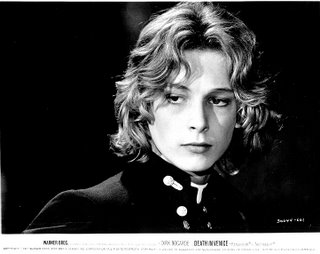


It was adapted into a movie in 1971. Movie shots of Tadzio
I'm making it sound like a movie review. I'll leave the lyrics interpretation to Jady. Enjoy!
Continues Jady…(I got to complain about the way Zhu habitually chucks unfinished posts to me, very funny, HMPF!)
M. Rufus has proved to us that he’s one well-read, deep-thinking modern poet (with an ‘expiring’ voice, sure) with all the alternatively dense or abstract lyrics he writes. Thomas May’s review of Poses says of Wainwright as having the ‘the singular, unclassifiable, ranging gift of singer/songwriter’. (See the full review at the bottom.) But appreciating the music is one thing, interpreting lyrics is another—which is particularly difficult with monsieur Wainwright who writes with such personal, almost cryptic voice. What’s ‘roller concrete clover?’ What’s ‘in between been dragging a dragonfly’? and what could ‘grey gardens’ possibly mean, apart from a barren, withered heart?

Updates: after some avid searching by Mlle. Zhu, we now have some interesting bg info about Grey Gardens, a 1975 documentary telling ‘the story of the aunt and first cousin of Jacqueline Kennedy Onassis and their everyday life at Grey Gardens, a decrepit 28-room mansion located in East Hampton, New York. Edith Bouvier Beale and her mother (also named Edith) lived together there for over twenty years in squalor and almost total isolation.’—so Grey Gardens is in part literally a desolate place, and in other part probably a metaphor for all that it stands for.
Thomas May's review on Poses

The scrutiny of success that came early on--being named Best New Artist by Rolling Stone in 1998, the year of his debut album, for example--would have smothered many another emerging talent. But it failed to stopper the singular, unclassifiable, ranging gift of singer/songwriter Rufus Wainwright. His sophomore album, Poses, advances beyond the earlier, cabaret-inspired effort with a suite of songs marvelously varied in arrangement and texture but linked by Wainwright's characteristic theatrical panache. "Cigarettes and Chocolate Milk" catalogs excess with playful self-censure, but Wainwright's whimsical ironies often take a bruising, poignant turn, whether in the pseudo-upbeat "California" or, most movingly, on the title track. The dying fall of Wainwright's lusher melodies--echoes of "Across the Universe" as well as ultrachic Beatles tunes such as "Michelle"--meshes remarkably with the poetic substance here as he explores a landscape of wistful self-knowledge caught between longing and decadence. Yet even through all the layers of picturesque, postmod observation, Wainwright conveys a sense-filtered experience that gives urgency to his hauntingly mumbled opacities. With Poses, the young artist proves his authenticity.
Sunday, April 02, 2006
Tool
filed under: downloads, north american, rock
Tool is a band that I started listening to in high school, and has remained a band that I listen to often. I'm not sure if it's something the rest of the ensemble would be into, but I thought they were worth putting up. I'm a bit worried that maybe you guys would find the videos repulsive? If it's too much, let me know and I'll take them down. I didn't think they were bad though.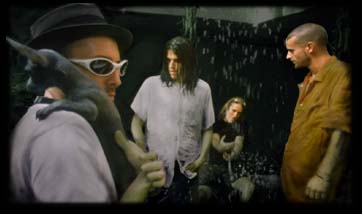
I'm not really into metal...rock and punk were more my style. However, Tool is a strange bird. Their guitar riffs are heavy, but their lead singer, Maynard James Keenan can really sing. He doesn't need to scream or yell, he's got a good singing voice. The thunderous guitar riffs even have their strange melodic quality after a while that can draw you in. For this reason they've been called "trance rock" or "trance metal" at times. Of course, the content of their songs is dark and generally disturbing.
Tool's wikipedia entry
Most of their songs are of human interest...the dark sides of life, death, religion, human failings, and sexuality. The band's mantra has always been "think for yourself." Some critics have called them "the thinking man's metal" because they touch on ideas that not a lot of other bands do. Some of their songs may seem like a creepy gothic metal-art-rock, but their videos really seem that way. They came in at the height of the alternative music craze, which made them popular with their album Undertow in 1993. The bleak and soul charing photos within the album helped set their tone and style. Their second album was Aenema, which came in 1996 after the alternative craze had ended...and it didn't do as well as their first album. In 2001, they released their third album was Lateralus, which became their biggest selling album...probably because of the lack of good hard rock on the American music scene at that time. They've had numerous shorter releases, including a "pre-album" called Opitate in 1991, but I've listed their main, easy-to-find releases.
As for the band members...they generally live normal lives and are pretty reclusive for "rock stars." Much that has been written about them is rumor and crap. They do not worship the devil...none of their imagery is satanic. If you want to read more about their lives....read here under biographies.
Vocals: Maynard James Keenan
Guitar: Adam Jones
Drums: Danny Carey
Bass: Justin Chancellor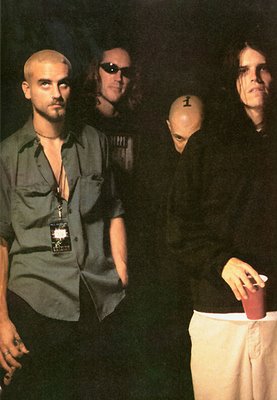
I've uploaded a sample of their music to YSI: Tool Selections
Here's also some links to their visually creative, but highly disturbing videos. The quality on them is not the best, but I think they're still kind of creepy. Imagine "Corpse Bride" gone wacko. Click on the photos for the videos. You'll need to be able to play real media files.
Prison Sex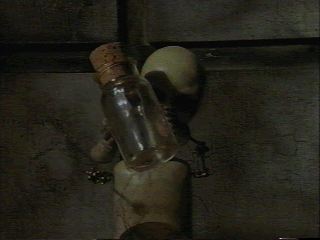
This is probably one their most disturbing and brilliant videos. It's strange, ugly, and heartwrenching at the same time. The song and the video are basically about child abuse. The singer, Maynard James Keenan, has been vocal about his dislike for his step-father...and you can probably follow the logic from there after seeing the video. Like most artists, he probably used it as material for the song and as an outlet for the abuse he suffered. The image of the broken doll that represented an abused child stayed with me a long time after I first saw it. It's pretty abstract, but I might still advise some caution if you're overly sensitive and good at decoding symbolism.
Stinkfist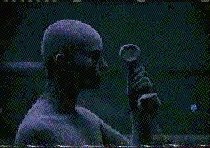
This is one of their more fun videos...it's just creepy and weird to be creepy and weird. It actually uses live actors and is a brilliant piece of abstract art, at least I do. The symbolism is a bit more straightforward, the easiest of which is "the opening of one's eyes to the truth, and shedding the lies that cover you." Watch as the main character has his eyes opened (when he inexplicably turns obsese) and sees all sorts of strange creatures.There are other metaphors...but they probably don't need to be explained here.
Edit: There's actually a slightly better quality streaming video at singingfool. Have to sit through a short commerical though.
There are other videos, but you can see them from the website listed above.
Limited Discography:

